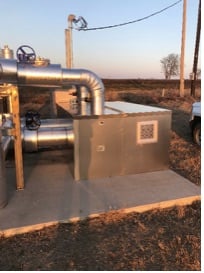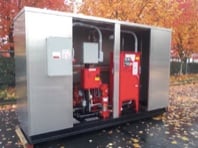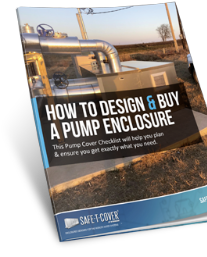When it comes to protecting pumps, a pump cover or pump enclosure is critical. Residential and commercial pumps must be covered, not only to keep them safe but to extend their life.
If you’re considering a cover or enclosure for your pump, we’re here to help. Here are answers to the five most commonly asked questions about pump covers.
How do I run influent and effluent piping from the enclosure?
Piping penetrations are a necessity when covering pumps. This allows the fluid (water or otherwise) to get to and from your pumps inside the enclosure. 
We typically recommend drilling the holes for the piping on the project site. This way the contractor can create the holes exactly where you need them. This will save you time and money if your design isn’t perfect.
You should also consider applying expanding foam in the gap around the piping where it intersects with the enclosure to retain heat.
What’s the best way to remove heat from my pump cover?
Many pumps naturally produce heat, and depending on what part of the country the project is located, it can get very hot inside the enclosure. It is important to remove heat so it doesn’t damage other equipment like electronic control panels. We recommend adding at least one louver and fan on opposite sides of the enclosure.
The idea is to pull air from the outside across the pumps and equipment and out of the other end of your enclosure. This causes a cooling effect and keeps your equipment from overheating.
When it comes to pump covers, size does matter. The size of your enclosure and your pump will determine the number of louvers needed. Consult with your enclosure company when deciding how many of each are needed.
Can I get access for routine maintenance and replacing equipment?
When designing an enclosure it’s important to make sure you have easy access to your equipment for maintenance and replacement.
For example, fire booster pumps need tested on a routine basis. This ensures they’re in good working order in case of an emergency. If you have equipment that requires regular maintenance, we recommend placing doors on the front of your enclosure. This is especially important when working with smaller enclosures.
If your equipment needs replaced, you’ll need easy access. If you’re working with larger pumps (inside a prefab building), make sure your doorways are wide enough and tall enough to move equipment in and out.
For smaller enclosures, a removable or hinged roof is a good option. Installing eye hooks for a crane to lift the entire enclosure off your equipment is also helpful.
You should also be able to lock all your doors and access panels. After all, not everyone should have easy access!
What if I need to heat my pump enclosure?
If your pump does not run continuously and you’re in a cold climate, or have cold winters, you’ll need a heater.
Pumps may also push fluids that are more viscous than others. Heating the interior of your enclosure helps keep fluids warm, which helps increase the efficiency of the pump.
There are many options regarding the specific type of heaters available. They include:
- Explosion proof
- Wall mounted
- Slab mounted
The size of your enclosure will determine things like:
- Insulation amount
- Watts and voltage
- Heater placement
For most cases, mounting the heater on the wall makes good sense. It provides the necessary heat and will stay out of the way of equipment.
Can pump enclosures be easily added to a skid?
Yes, enclosure companies should have a way to easily mount your enclosure to a skid. Providing detailed dimensions of the size of the skid is very helpful to the manufacturer. Considering what clearances are needed inside the enclosure is also important when marrying the two together. 
Want To Know More?
The staff at Safe-T-Cover is always happy to answer these and others you may have about custom covers. Our pump enclosure experts want to ensure the best protection for your equipment. Our guide: “How to Design and Buy a Pump Enclosure” can also help. This checklist walks you through all of the necessary steps.
If you'd like to talk about your specific pump cover needs, please give us a call at 800-245-6333 and ask to speak with Chris Nickoloff.





